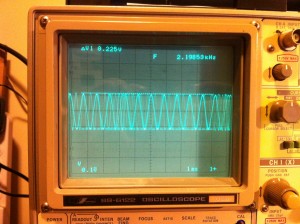I recently purchased a couple of HX1 transmitters for the 144.39 packet frequency from RadioMetrix. I’ve already set up a widget to generate the necessary tones for APRS, so it was a quick matter to connect up the transmitter and the tone generator for a test.
As a reference, here’s a photo off my oscilloscope displaying the output signal from the tone generator.
You can safely ignore the frequency counter. While the tones are switching between 1200hz and 2200hz, it’s kinda hard to count them. Also, I used a 10x probe, so the peak to peak voltage level listed is 2.25V rather than 0.225V. Lastly, the second division from the bottom is 0V, so as you can see, my tone generator biases the output up a bit to about 2.5V.


The reason of low amplitude on 2200 Hz is simple. There is deemphasis circuit on receiving radio, but it is not present in HX1 module (this module is dedicated to digital FSK transmission). Add simple op-amp and preemphasis circuit (high pass filter to lower the amplitude of 1200 Hz tone) Thats all :-)
73!
Unforunately that’s not the entire story. The radio I’m using for testing receives the 1200hz tones and 2200hz tones from other local packet sources at the same amplitudes, as well as I have looked at the output of the HX1 module on a spectrum analyzer and it shows reduced levels for the 2200hz tone as well. I do suppose that a filter to lower the amplitude of the 1200hz tone feeding the HX1 would bring the two tones closer together, but it’s a poor “fix” for the module not handling the higher frequencies well. However, even if it’s not perfect, it is certainly usable. Thanks for the thoughts and the comment!
Nigel, local packet sources was preephasized in normal FM modulation path, data sent via HX1 was not. Thats the point :-)
73, Tom SP9UOB
I had some experience using HX1-144.390-3 connected to a tinytrak equivalent device for high alt. balloon use. The the full audio output from the tracker pic chip had to be used to get as much deviation as possible from the transmitter. The audio coupling from tracker to Tx was a resistor capacitor which provided a degree of pre-emphasis. I checked the Tx output with a Deviation Meter (no de-emphasis) and had the following results
1200 tone 1.93 kHz deviation
2200 tone 1.8 kHz.
With the degree of pre-emphasis on the tracker, I would have expected more deviation on the 2200 tone but I guess this was limited by the bandwidth of the HX1-144.390-3. When the signal is received by a normal receiver, with de-emphasis, the the 2200 tone is knocked down even futher.
I am interested in any tests on the HX1-144.390-10 unit (with the higher bandwith). Does anyone have some results yet.
Mike
Mike, I do have a -10 unit now, and have done a little bit of fiddling with it. I don’t have any exact numbers, and I don’t have a deviation meter, but using the same testing method as before, no pre-emphasis, into the same receiver, it appears that it’s not perfect, but it is better. If say you look at the video above using the -3 module and see that the 2200Hz tone maybe a bit under half, then the -10 might bring it up to a bit under two thirds.
I ended up using a -10 module on a APRS system with no pre-emphasis on a balloon this spring, and ended up having very good results until the tracker died. So as mentioned before, even if it’s not perfect, it still works reasonably well.
Nigel
Nigel, thanks for your comments and please disregard my post of today. I didn’t realize that my remarks of yesterday had gotten through.
Mike
Hi Nigel,
I know its been a while since you probably played with your HX1 transmitter, but I am attempting to test one and appear to either be doing it wrong or I’ve broken it.
I can get the transmitter to key, but the audio doesn’t seem to be anything close to a 1200hz tone, let alone a tone at all.
Just wondering if you would know if switching the voltage between 0v and 5v on the TXD pin whilst transmitting is all that you would need to get a correct hz tone. At least something to test that the transmitter is working clearly.
David,
It sounds like you’re expecting the HX1 to act like the NTX2. In the case of the NTX2, the voltage you put in is proportional to the frequency that comes out of the radio on the other end. However, this is not the case with the HX1. You must provide an audio signal into the HX1 to get audio out the other end. In the case of packet, your 1200 and 2200hz tones.
I’m not sure if you’re using a project like trackuino, but that software will generate those tones for you. You can test that they’re being played by hooking up a small speaker to the pin they use to send the tones. Then, sending that signal to the HX1 (at an appropriate level), you should get that audio out the other end.
Remember once you have this set up that you may need to adjust the signal level of what you’re feeding into the HX1. If you feed too much or too little, your packets may be difficult or impossible to decode. I recommend using a variable resistor (potentiometer), to reduce the audio level, and allow for adjustment. Then, with your receiver, listen to other people’s packets on 144.390, and adjust the potentiometer until your volume matches theirs as close as possible. It’s not the BEST method for setting your deviation, but it will get you in the ballpark.
Hope this helps!
Nigel